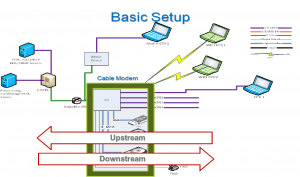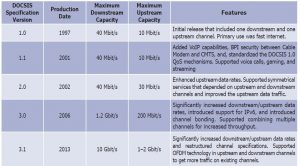Introduction
Many homes are connected to broadband internet on the cable network – an alternative to ADSL internet over telephone lines – and enjoy high speed internet.
However, not many know that this internet communication is made possible by a modem that is connected to the coax cable on one end and various consumer electronic devices on the other end.
This article describes the international DOCSIS* specification that helps set up the communication network – via the modem – to pass the information between the network and devices.
 The History of DOCSIS
The History of DOCSIS
Data Over Cable Service Interface Specification, known as DOCSIS, is a specification invented in 1997 that defines the communication between all the components of the systems that enable passing data information through coax cables1.
The cable network consists of coaxial cables which transmit the TV streaming in the homes and pass electronic energy as radio frequency in a different spectrum of signals. This means letting radio waves pass through cables instead of passing in the air.
Through these cables, it is possible to pass internet, video, and VoIP calls in parallel. In Israel, this solution is commonly known as the triple package deal.
The DOCSIS specification was invented, and continues to be modified and improved, by Cable Television Laboratories, Inc, known as CableLabs*, as an alternative to telephony services that were previously the only way to deliver digital data to homes. CableLabs is a cable operators consortium and currently manages both the specification and certification programs to signify whether or not a product complies with the specification standard, and then marks it as such for the public.
In the latest DOSCIS 3.1 specification, orthogonal frequency-division multiplexing (OFDM2) is a key feature that increases bandwidth by enabling the bundling of dense 25KHz “sub carriers” channels of up to 192Mhz, as opposed to the Europe 8MHz / United state 6MHz of Single Carrier Quadrature Amplitude Modulation (SCQAM3) channels. The granularity of channel width helps to use sparsely spread spectrum, to achieve higher throughput.
Combining a new generation of Forward Error Correction (FEC4) called LDPC5 with OFDM enables use of the existing cable infrastructure without digging tranches around a home, which allows the technology to be easily deployed. The standard also improves the cost of every bit with the Active Queue Management (AQM6) which enables better management of queues in the system and improves the response time (known as latency).
The DOCSIS specification continues to evolve. Due to other service needs, such as Over The Top (OTT7), video, 4K video, 3DTV, etc., there are discussions about the upcoming Bi-Directional/Full Duplex DOCSIS 3.1 specification that will enable upstream and downstream channels on the same spectrum in parallel, as opposed to the dedicated upstream channels and different dedicated downstream channels in 3.1 Half Duplex. This makes it possible to increase the bandwidth and enable these services.

Image 1: Example of a system
The Current DOCSIS Status
Today, DOCSIS 3.1 is used in European or US specifications, which differ in channel spacing etc. and upstream and downstream traffic speed.
Physical channels cannot pass unlimited traffic of information. To overcome this limit and to achieve a certain bit rate, this specification combines or “bonds” several channels and links them together, thereby enabling wide broadband downstream and upstream channels.
Most of the traffic is on the downstream channel, such as downloading of media movies files, etc., and less so on the upstream channel which is used for uploading to the cloud or other services. This results in asymmetric traffic.
For the downstream channel, there are 32 SCQAM channels and two OFDM channels. For the upstream channel, there are eight SCQAM channels and two OFDMA (Which is OFDM technology for the Upstream) channels.
If every SCQAM channel has a physical limitation and supports 27-50 Mbps, the combination of 32 downstream channels with two OFDM and eight upstream channels with two OFDMA provide the following bandwidth:
In the U.S. and Israel
Downstream:
(32 channels * 38Mbps = 1,216Mbps) + (2 channels OFDM * 1880Mbps = 3,760Mbps)
Total: ~4,976Mbps
Upstream:
(8 channels * 27 Mbps = 216Mbps) + (2 OFDMA channels * 940Mbps = 1,880 Mbps)
Total: ~ 2,096Mbps
In Europe
Downstream:
(32 channels * 50Mbps=1600 Mbps) + (2 OFDM channels * 1,880 Mbps = 1,400 Mbps)
Total: ~ 5,360Mbps
Upstream:
(8 channels * 27 Mbps = 216Mbps) + (2 OFDMA channels * 940Mbps = 1,880 Mbps)
Total: ~2,096Mbps
The Future of Cables
General System Components
CMTS8, content servers, security servers, TFTP servers, telephony servers, time servers, Cable modem, consumer devices connected via Ethernet or Wi-Fi, etc.

Nehorai Vaisler, Intel
Cable Modem Enables Connectivity to Consumer Devices
People connecting via cable internet have several ways to connect to the cable modem, such as a ethernet cable, Wi-Fi, Multimedia Over Coax Alliance (MoCA*9 which substitutes a wired home network running over coax cable infrastructure) and smart home networking technologies such as Bluetooth*, Zigbee*, and more.
The CMTS is managing the network, and sends commands and instructions to modems to enable the network to optimize the synchronization of transmission time, frequency, and transmission intensities. This enables the transmission of information at high rates without interruption.
The Interconnection between Consumer Devices and How the specification Relates to Them
Network management is the sole responsibility of the CMTS. This equalizes and controls the traffic on the network. In addition, this gives the CMTS the authority to enforce the specification, and forces the cable modems to comply with the specification.
Different Cable Modem Modes from Power-up to Full Wide Bandwidth
The starting point of the cable modem is that the CMTS periodically transmits unique characteristics of data traffic on specific channels in broadcast to the whole network.
When the cable modem powers up, it scans all channels using a hardware tuner, and traffic gradually starts streaming using a state machine. A handshake procedure between the cable modem and the CMTS is initiated through a software code running on the cable modem.
Gradually, the cable modem locks on all channels, becomes operational, and can pass the traffic.
When the handshake process fails, there is a time out during which the cable modem tries the failed step of the process again. If the cable modem is unsuccessful, it starts the process from the beginning.
Intel and the DOCSIS Device Market
Intel is a leading provider of DOCSIS network solutions for cable modems and gateways and much of the product development happens in Israel. Intel has also been investing in and leading cable broadband innovations for many years to speed innovation, including playing a leading role in the development of DOCSIS specifications.
The Intel® Puma™ 7 SoC10 is a leading DOCSIS 3.1 solution that enables support for increased bandwidth, is architected for a wide range of use cases on the WAN and LAN side, and is being implemented in a range of devices worldwide. Intel also offers a portfolio of Wi-Fi and Ethernet solutions that are optimized for use with Intel Puma SoCs for integrated home gateway platforms that can deliver high-performance connectivity.
Summary
The DOCSIS specification is the leading specification for internet services and is widely deployed worldwide. It meets consumer demand for high-speed connections and sophisticated applications by improving broadband speed, quality of experience, energy efficiency and capacity and has paved the way for high-bandwidth broadband with one gigabit speeds available to more than 80 percent of U.S. cable households today. Full Duplex DOCSIS, with symmetrical speeds, will expand upon that groundwork and will make it possible to deliver multi-gigabit upload and download speeds over the connections already present in hundreds of millions of homes. It is a significant piece of the 10 Gigabit platform, supported by Intel, Internet service providers and others.
Cable specification continues to innovate and evolve to keep up with increasing demand for bandwidth, and more connected devices in the home.
*Other names and brands may be
claimed as the property of others.
Intel and Puma are trademarks of Intel
Corporation or its subsidiaries in the
U.S. and/or other countries
About the author
The author Nehorai Vaisler is “Business
Customer Application Development
Engineer”, Docsis Domain Expert, in
CHD (Connected Home Division), Intel.
/http://il.linkedin.com/in/nehoraivaisler



 The History of DOCSIS
The History of DOCSIS



